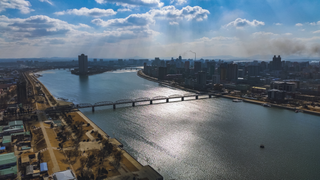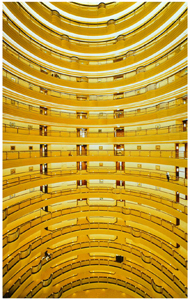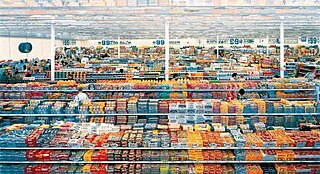
The Rungrado 1st of May Stadium is a multi-purpose stadium occupying an area of 20.7 hectares on Rungra Island, Pyongyang, North Korea. It opened on 1 May 1989, with its first major event being the 13th World Festival of Youth and Students. It is the second largest stadium in the world by seating capacity, after Narendra Modi Stadium. The stadium can officially hold up to a maximum of 114,000 spectators.

Andreas Gursky is a German photographer and professor at the Kunstakademie Düsseldorf, Germany.

The Grand Mass Gymnastics and Artistic Performance Arirang, also known as the Arirang Mass Games, or the Arirang Festival is a mass gymnastics and artistic festival held in the Rungrado 1st of May Stadium in Pyongyang, North Korea. The games usually take place in August or September. The Arirang Mass Games were held annually between 2002 and 2013, with the exception of 2006. After a five-year hiatus, Mass Games returned for a performance entitled 'The Glorious Country' in 2018.

Mass games or mass gymnastics are a form of performing arts or gymnastics in which large numbers of performers take part in a highly regimented performance that emphasizes group dynamics rather than individual prowess.

Historically, North Korea's participation in international sporting events has been hindered by the relations with South Korea. Until the 1990s, North Korea used to host up to 14 international events every year, albeit in small scale. Since the early 1990s, the amount was reduced to just one, the Paektusan Prize International Figure Skating Festival. More recently, since the 2000s, North Korea both participates in and hosts more international competitions.

99 Cent II Diptychon is a two-part colour photograph made by Andreas Gursky in 2001. It was based on an original photograph called 99 Cent, from 1999, sometimes called "99 cent.1999".

Rhein II is a colour photograph made by German visual artist Andreas Gursky in 1999. In the image, a river flows horizontally across the field of view, between flat green fields, under an overcast sky. Extraneous details such as dog walkers and a factory building were removed by the artist using digital editing.

The Taedong Bridge (Korean: 대동교) is a bridge over the Taedong River in Pyongyang, North Korea.
Chicago Board of Trade II is a colour photograph by German artist Andreas Gursky made in 1999. It was created following his usual process of taking several pictures of the same subject and then manipulating and merging the scanned results by computer.
Chicago Board of Trade, also known as Chicago Board of Trade I, is a colour photograph made by German artist Andreas Gursky in 1997. It is the original picture that he took of the Chicago Board of Trade, of which he would make new versions in 1999 and in 2009. The photograph had six editions, one of which is at The Broad Museum, in Los Angeles. It is also a part of a series that the artist made on the subject of stock exchanges and board of trades across the world, since 1990.
Chicago Board of Trade III is a color photograph made by German artist Andreas Gursky in 1999–2009. It is the third version of the original picture, previously titled Chicago Board of Trade (1997) and Chicago Board of Trade II (1999). The artist used the same previous process of manipulating the images by computer before achieving the final result. These three pictures were part of a series dedicated to the worldwide "Stock Exchanges".
Los Angeles is a colour photograph made by German visual artist Andreas Gursky in 1998. It is an edition of six. The image was manipulated by computer, following the artist usual process. Its one of the largest examples of the artist's work.
Paris, Montparnasse is a colour photograph created by German photographer Andreas Gursky in 1993. The large photograph has the overall dimensions of 210 by 395 cm, and had a five copies edition.
Rhein, also known as Rhein I, is a colour photograph created by the German photographer Andreas Gursky in 1996. The photograph had a six copies edition. This was the first version of a photograph that become better known with his second version, Rhein II, in 1999.

Shanghai is a color photograph by German photographer Andreas Gursky created in 2000. The photograph has variable large dimensions, with the one held at the Art Institute of Chicago having 306 by 206 cm, and has a six prints edition.
Frankfurt is a colour photograph created by German photographer Andreas Gursky in 2007. It was created by his usual method of digital manipulation. It has a six copies edition. It depicts a scene taking place at the boarding lounge of the Frankfurt Airport, in Germany.

99 Cent is a colour photograph by German photographer Andreas Gursky, created in 1999. It depicts a view of the interior of a 99 cent store in Los Angeles. It was created with the use of digital manipulation, like the artist has done for his work since 1990. The photograph was included in Time magazine's 1999 list of the 100 most important photographs ever taken. Gursky made a new version of this photograph, 99 Cent II Diptychon, in 2001, which would be one of the most expensive ever sold.
Untitled V is a color photograph made by German photographer Andreas Gursky, in 1997. It had an edition of six prints. The picture follows the usual method of digital manipulation used by Gursky since 1990.
Working Students is a black and white photograph by German photographer August Sander, taken in 1926. The photograph depicts a group of four students, who also worked for a living, from the Weimar Republic. It was included in his photography landmark book Antlitz der Zeit (1929), and became one of the most famous pictures that Sander took back then.










